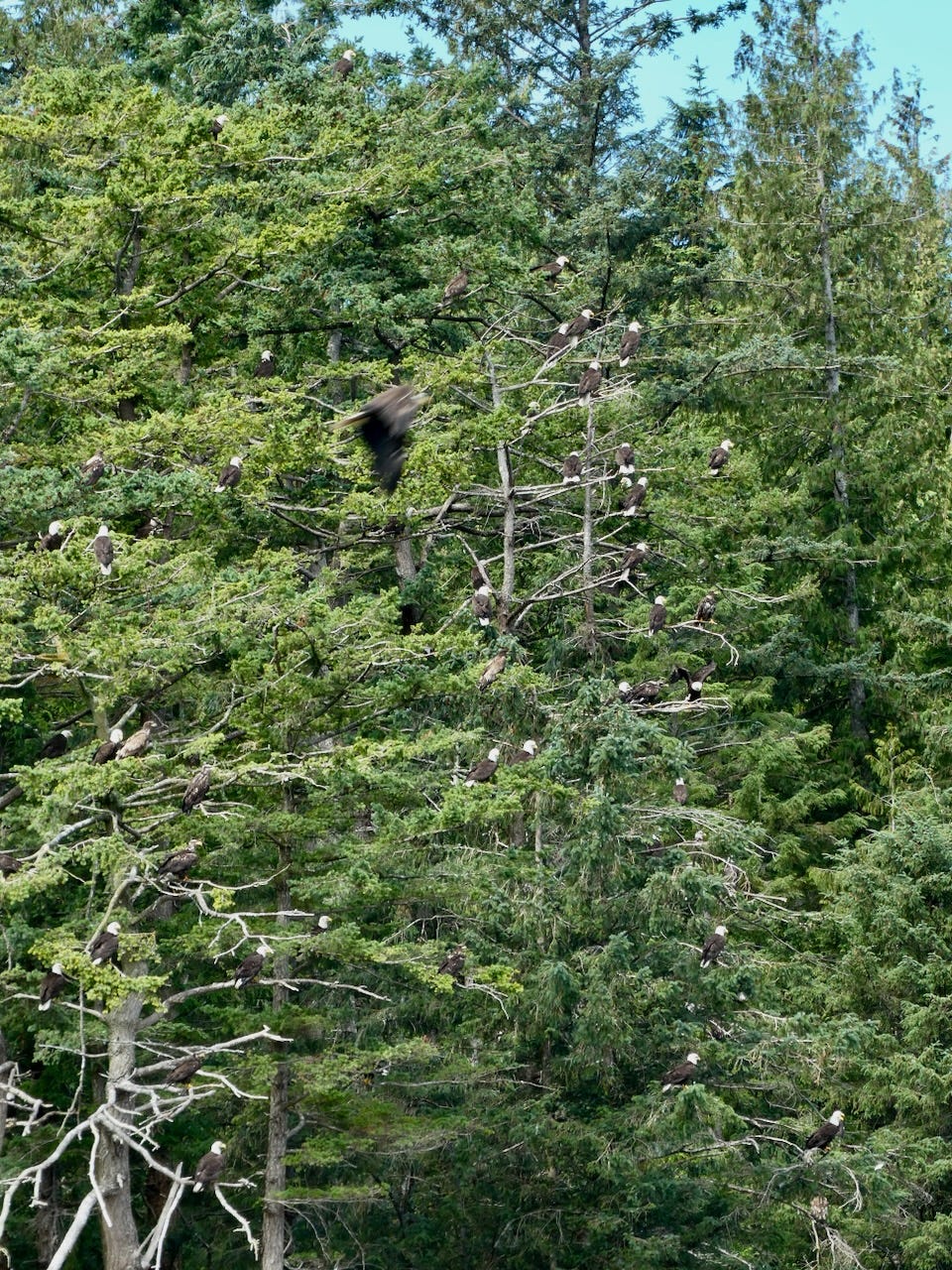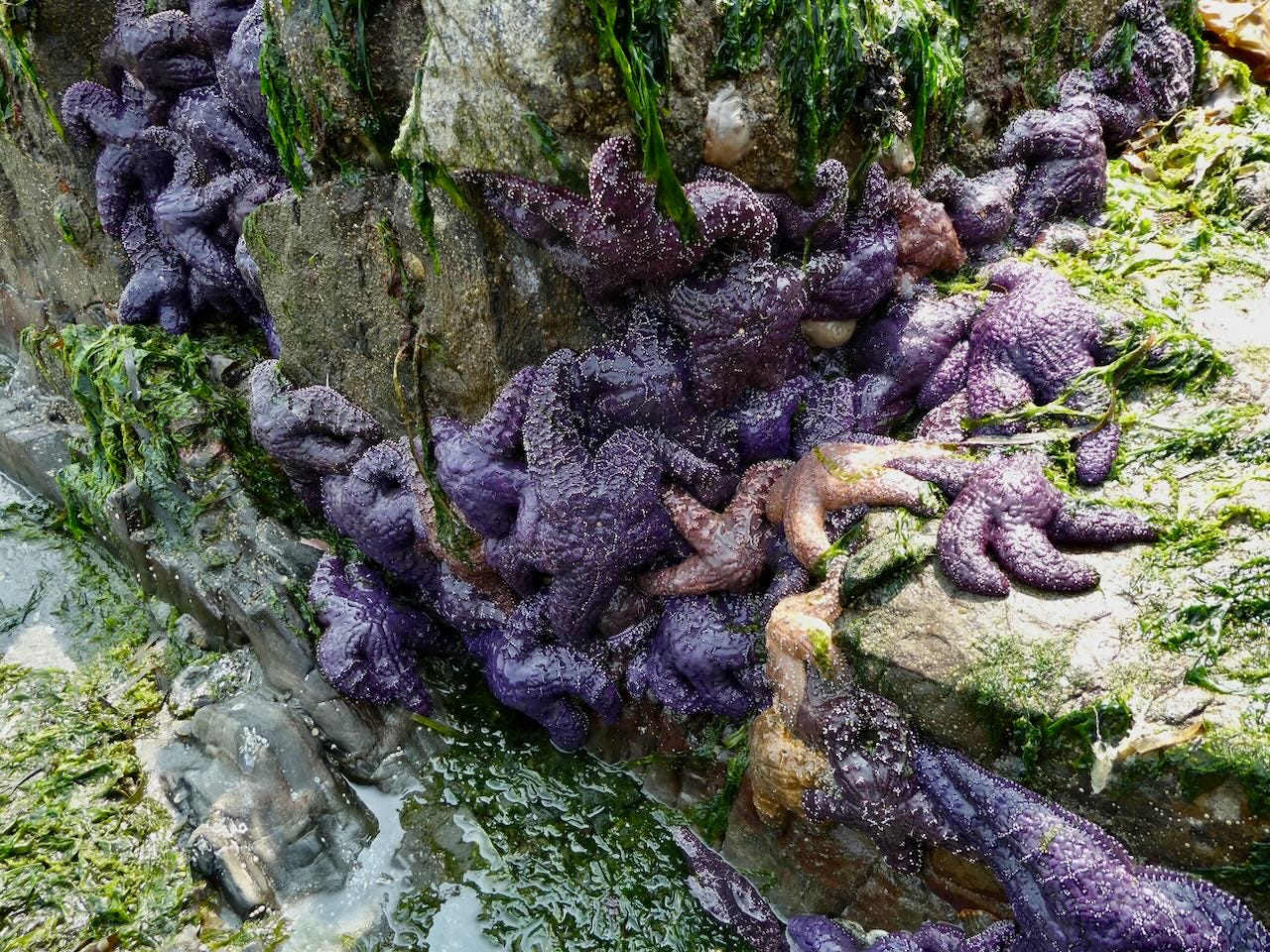Recently my wife and I headed up to Canada to see friends and wildlife. Since I know not everyone wants to read about our pals, I thought I’d write about some of the wonderful wildlife we saw.
Eagle Swarms
As someone who habitually tracks the number of eagles I see each year, I am thrilled when I see more than five in a day so you can imagine how excited I was when I saw several hundred in an ebullient mass of avian chaos. In one location no bigger than a soccer pitch.
The eagle maelstrom was at Jimmy Judd Island, about 24 miles northeast of Campbell River, BC. For a handful of weeks in early summer, tides produce an upwelling of water that coincides with schooling Pacific hake (aka Pacific whiting). Relatives of cod, hake are generally bottom dwellers that rely on a swim bladder to achieve neutral buoyancy. The upwellings though carry the fish from deep water to the surface and their bladders cannot compensate. Unable to descend the hake become an ideal meal for eagles.
Traveling from who knows how far (covering 40- or 50-plus miles is no big deal for balds) and taught by their parents (eagles are well known to watch and follow other eagles to food), bald eagles arrive by the hundreds (our guide estimated 500) to feast on the 12- to 20-inch-long fish. The concentration of the big birds (immature and adult) was astounding. I counted more than 130 perched in the trees (and I was only counting adults), where they were calling, eating, chilling, and defecating (it must not be pleasant to be pooped on from above but no one seemed to exclaim when this happened). Out in the water, where the upwellings caused massive whirlpools (our boat had two, 250hp engines to keep us safe), the eagles were diving, soaring, chasing, swooping, and catching fish after fish after fish.
It felt like we were in mosquito swarm with the world’s largest mosquitos—bald eagles. I have longed wanted to be in such a riotous gathering of life and it was truly special to be there.
Stumped Again
As Miracle Max said in The Princess Bride, “There's a big difference between all dead and mostly dead. Mostly dead is slightly alive.” Such is the case with a curious type of Douglas fir stump we saw on Salt Spring Island. Felled by ax or saw, these stumps continue to grow despite the amputation of their trunk, their limbs, and their photosynthesizing needles. Growth though is sort of an overstatement; the tree produces a callus of wood and bark that helps protect the stump from fungus and pathogens but does not continue to make the stump taller. I still think they are PDN, or pretty darned nifty!
The energy for life comes from two sources. When trees send out roots they may intersect other roots, connect, and share resources, creating a family of knit together organisms. A similar collaboration, or what some call the wood wide web, can form through linked mycorrhizae, the fungal network so critical to the health of forest ecosystems. One study in the Sierra Nevada found living stumps could start in trees as young as 35 and as old as 200 and that stumps could remain alive for up to 200 years.
What’s curious to me is that I have only ever encountered living stumps on islands. (The other spot was San Juan Island.) They must be in other places but I clearly missed them.
Galaxy of Hope
For the past decade or so, one of the saddest stories of our coastal region has been sea star wasting disease. Linked to a group of viruses known as densoviruses, the disease caused sea stars to disintegrate into piles of limbs and skeletal bits. Some areas suffered so much death that they were completely devoid of sea stars. Initially identified in Washington in 2013, SSWD hit 23 species, including the ubiquitous, charismatic, and beautiful (and deadly, if you are a fellow invertebrate) ochre stars (Pisaster ochraceus).
Not having seen more than a one or two ochre stars at a time over the past decade, it was incredibly exciting and hopeful when we came upon a galaxy, or constellation, of them at Beddis Beach on Salt Spring Island. Dozens were grouped together on the shady side of a low outcrop of rock exposed only at very low tides. When a biologist pal of mine saw the photo below, he wrote: “That is hella cool - like the old days!”
He added that research on ochre stars in California has shown that those that survived the disease may pass on their more resistant genes to subsequent generations, which may lead to the species being better adapted for future outbreaks. Evolution in action. As Emily Dickinson could have written if she lived out here: “Hope is a galaxy of sea stars.”
I just had to include this early description of our local sea stars. In his journal entry for December 6, 1824, when he was in Puget Sound, John Work of the Hudson’s Bay Company wrote: “another kind of fish in a curious shape was also plenty, this is a shapeless animal with long toes joined together in the middle, it seems to be in a torpid shape and scarcely to move, it is covered with a crust or hard skin of reddish color.”
Mr. Work also used a phrase I find appealing. “Weighty rain the greater part of the day.” “Some weighty rain in the night.” “Weighty rain in the afternoons.” That about sums up our winters.







Bremerton's Forest Ridge Park has a few of those living stumps, all less than about 10 inches diameter.
.
There is a living stump at Dunn Garden in north Seattle.
Love your newsletter!